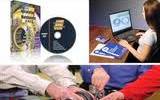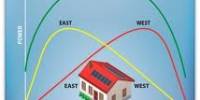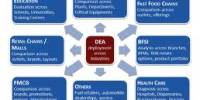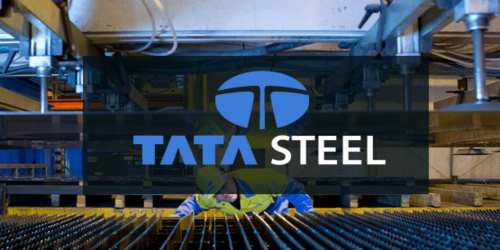Ford Motor Company
The Ford Motor Company is an American multinational corporation based in Dearborn, Michigan, a suburb of Detroit. The automaker was founded by Henry Ford and incorporated on June 16, 1903. In addition to the Ford, Lincoln, and Mercury brands, Ford also owns Volvo Cars of Sweden, and a small stake in Mazda of Japan and Aston Martin of England. Ford’s former UK subsidiaries Jaguar and Land Rover were sold to Tata Motors of India in March 2008.
Ford introduced methods for large-scale manufacturing of cars and large-scale management of an industrial workforce using elaborately engineered manufacturing sequences typified by moving assembly lines. Henry Ford’s methods came to be known around the world as Fordism by 1914.
The Ford Motor Company was launched in a converted factory in 1903 with $28,000 in cash from twelve investors, most notably John and Horace Dodge (who would later found their own car company). Henry’s first attempt under his name was the Henry Ford Company on November 3, 1901, which became the Cadillac Motor Company on August 22, 1902. During its early years, the company produced just a few cars a day at its factory on Mack Avenue in Detroit, Michigan. Groups of two or three men worked on each car from components made to order by other companies. Henry Ford was 40 years old when he founded the Ford Motor Company, which would go on to become one of the world’s largest and most profitable companies, as well as being one to survive the Great Depression. As one of the largest family-controlled companies in the world, the Ford Motor Company has been in continuous family control for over 100 years.
Recent Company Developments
During the mid to late 1990s, Ford sold large numbers of vehicles, in a booming American economy with soaring stock market and low fuel prices. With the dawn of the new century, legacy healthcare costs, higher fuel prices, and a faltering economy led to falling market shares, declining sales, and sliding profit margins. Most of the corporate profits came from financing consumer automobile loans through Ford Motor Credit Company.
In the latter half of 2005, Chairman Bill Ford asked newly-appointed Ford Americas Division President Mark Fields to develop a plan to return the company to profitability. Fields previewed the Plan, dubbed The Way Forward, at the December 7, 2005 board meeting of the company; and it was unveiled to the public on January 23, 2006. “The Way Forward” includes resizing the company to match current market realities, dropping some unprofitable and inefficient models, consolidating production lines, and shutting fourteen factories and cutting 30,000 jobs.
On June 2, 2008, Ford sold its Jaguar and Land Rover operations to Tata Motors for $2.3 billion.
Ford’s target is to become profitable again in 2009, a year later than projected. Ford’s realignment also includes the sale of its wholly owned subsidiary, Hertz Rent-a-Car to a private equity group for $15 billion in cash and debt acquisition.
In March, Ford gained retail market share for the 17th time in the last 18 months.In April 1, 2010 – Ford punctuated a strong first quarter with a 43 percent sales increase in March. Ford, Lincoln and Mercury dealers delivered 178,546 new vehicles in March. First quarter sales totaled 428,596, up 37 percent. The 43 percent gain matches a similar increase in February. These are the highest monthly sales increases since February 1984.
Marketing Strategies of Ford
“Marketing is a creative problem solving process. And, whether the process ends with a richer customer experience, relevant brand positioning and creative which resonates with a key audience is up to you. We are here to help”, this is the marketing slogan of Ford.
At Ford they believe that successful marketing is not about clever slogans, stunning visuals, creative copy, or front page headlines.
Marketing is an on-going, never-ending process. And at Ford, it’s the passion. They believe that every client is unique; because the customer who matters the most to you comes in all shapes and sizes. Ford has proven track record of helping recognized brands like Six Flags, IMAX, and the Houston Zoo succeed. Oh sure, you say, it’s easy to produce results with a household name.
No matter your name, marketing budget or brand awareness, it is essential to create a relevant customer experience and then make sure to communicate in a way that lets your customer know they matter to you.
The Sources of Brand Equity
Customer based brand equity occurs when the consumer has a high level of brand awareness and familiarity with the brand and holds some strong, favorable and unique brand associations in memory. Brand equity involves both the component value of a brand and brand value. Brand equity enhances the value of a product and creates a positive environment for the company to increase prices.
Ford is currently the fourth-largest automaker in the world based on number of vehicles sold annually, directly behind Volkswagen. And it makes them possible only because of their reputation, brand awareness and the brand image. In 2007, Ford fell from second to third in US annual vehicle sales for the first time in 56 years, behind only General Motors and Toyota. However, Ford occasionally outsells Toyota in shorter periods (most recently, during the summer months of 2009). As of 2008, Ford has become the second largest automaker in Europe (only behind Volkswagen), with sales that occasionally exceed those in the United States and large markets in Germany, Italy, and the United Kingdom. Ford is the seventh-ranked overall American-based company in the 2008 Fortune 500 list, based on global revenues in 2008 of $146.3 billion. In 2008, Ford produced 5.532 million automobiles and employed about 213,000 employees at around 90 plants and facilities worldwide. Starting in 2007, Ford received more initial quality survey awards from J. D. Power and Associates than any other automaker. Five of Ford’s vehicles ranked at the top of their categories and fourteen vehicles ranked in the top three.
Ford Motor Company manufactures automobiles under several names including Lincoln and Mercury in the United States. In 1958, Ford introduced a new Marque, the Edsel.Later, in 1985, the Merkur brand was introduced to market Fords from Europe in the United States; it met a similar fate in 1989.
Ford has major manufacturing operations in Canada, Mexico, the United Kingdom, Germany, Turkey, Brazil, Argentina, Australia, the People’s Republic of China, and several other countries, including South Africa where, following divestment during apartheid, it once again has a wholly owned subsidiary. Ford also has a cooperative agreement with Russian automaker GAZ.
Brand Awareness
Brand awareness is related to the strength of the brand node or trace in memory as reflected by consumer’s ability to recall or recognize the brand under different conditions. The levels of brand awareness are the depth and breadth. The depth of brand awareness relates to the likelihood that the brand can be recognized or recalled. The breadth of brand awareness relates to the variety of purchase and consumption situation in which the brand comes to mind. Brand recognition requires that consumers can correctly discriminate the brand as having been previously seen or heard. Brand recall relates to consumers’ ability to retrieve the brand from memory when given the product category.
In case of the brand Ford, the consumer can easily recall or recognized the brand name, its symbol and logo. Its name is simple, easy to memorize, easy to spell and of course familiar. And in the case of consumption situation Ford have different types of product category that means the models.
Initially, Ford Motor Company models sold outside the U.S. were essentially versions of those sold on the home market, but later on, models specific to Europe were developed and sold. Attempts to globalize the model line have often failed, with Europe’s Ford Mondeo selling poorly in the United States as the Ford Contour, while U.S. models such as the Ford Taurus have fared poorly in Japan and Australia, even when produced in right hand drive. The small European model Ka, a hit in its home market, did not catch on in Japan, as it was not available as an automatic. The Mondeo was dropped by Ford Australia, because the segment of the market in which it competes had been in steady decline, with buyers preferring the larger local model, the Falcon. One recent exception is the European model of the Focus, which has sold strongly on both sides of the Atlantic. Ford in Germany and Ford in Britain built different models from one another until the late 1960s, with the Ford Escort and then the Ford Capri being common to both companies. Later on, the Ford Taunus and Ford Cortina became identical, produced in left hand drive and right hand drive respectively. Rationalization of model ranges meant that production of many models in the UK switched to elsewhere in Europe, including Belgium and Spain as well as Germany. The Ford Sierra replaced the Taunus and Cortina in 1982, drawing criticism for its radical aerodynamic styling, which was soon given nicknames such as “Jellymould” and “The Salesman’s Spaceship.”
Through its relationship with Mazda, Ford also acquired a stake in South Korean manufacturer Kia, which built the (Mazda-based) Ford Festiva from 1988–1993, and the Ford Aspire from 1994-1997 for export to the United States, but later sold their interest to Hyundai (which also manufactured the Ford Cortina until the 1980s). Kia continued to market the Aspire as the Kia Avella, later replaced by the Rio and once again sold in the US.
Ford’s presence in Asia has traditionally been much smaller, confined to Malaysia, Singapore, Hong Kong, the Philippines, and Taiwan, where Ford has had a joint venture with Lio Ho since the 1970s. Ford began assembly of cars in Thailand in 1960, but withdrew from the country in 1976, and did not return until 1995, when it formed a joint venture with Mazda called Auto Alliance.
Ford India began production in 1998 with its Ford Escort model, which was later replaced by locally produced Ford Ikon in 2001. It has since added Fusion, Fiesta, Mondeo and Endeavour to its product line.
Current Ford E85 Flexible Fuel Vehicles sold in North America and Europe is:
- Ford F-150
- Ford Crown Victoria
- Ford Focus
- Ford C-MAX
- Ford Mondeo
- Ford S-MAX
- Ford Galaxy
- Ford Taurus
- Ford Ranger
- Ford Explorer
- Ford Expedition and EL/Max
- Mercury Grand Marquis
- Lincoln Town Car
The Ford Mustang has arguably been Ford’s most successful sports car. Jerry Titus won the 1965 SCCA Pro B National Championship with a Mustang and the model went on to earn Ford the SCCA Trans-Am Championship title in both 1966 and 1967. Ford won the Trans-Am Championship again in 1970 with Parnelli Jones and George Folmer driving Boss 302 Mustangs for Bud Moore Engineering. Ford took the 1985 and 1986 IMSA GTO Championship with Mustangs driven by John Jones and Scott Pruett before returning to Trans-Am glory with a championship in 1989 with Dorsey Schrader. Ford dominated Trans-Am in the 1990s with Tommy Kendal winning championships in 1993, 1995, 1996, and 1997 with Paul Gentilozi adding yet another title in 1999. In 2005 the Ford Mustang FR500C took the championship in the Rolex Koni Challenge.
There are some officials in the company who believe that Ford has down the years only launched new vehicles of different models without laying having a knack for advertisements. The need of the hour is in fact to increase optimum connectivity with the consumers in the market. So with all these different models, strategies sometimes they fall a deep loosing situation, sometimes they are in peak position .They overcome this different conditions, situations with the help of their loyal consumers, their awareness about this brand and because of these always they hold the market actively.
Brand Associations
Brand association, which is defined as “anything linked in memory to a brand”, is one of the major components of brand equity. Brand association includes, for example, the extent to which a consumer can recognize Brand like Ford among other competing brands like Toyota, Tata, Mercedes etc and the extent to which some characteristics of Ford Brand come to his/her mind quickly. It can be argued that brand association is complex and connected to one another. One reason could be that brand association is composed of several ideas, episodes, instances, and facts that establish a solid network of brand knowledge. The brand association is strengthened when it is based on several experiences or exposures to brand communications.
Brand association, which results in high brand awareness, is positively related to brand equity because it can represent brand quality and brand commitment. It also helps a consumer to consider the brand at the point of purchase, therefore, leading to a favorable behavior for the brand. In addition, as consumers are exposed to a brand’s advertising more frequently, they develop higher brand awareness and associations.
In the past Barack Obama is more associated with brands BMW, but while John McCain brings to mind Ford, he switched over to Ford. He was attracted by the various features, facilities of this brand Ford.
The extent to which a brand is strong, favorable, and unique has important implications for the brand success.
Strength of Brand Association
Strong brand associations are created by marketing program that convey relevant information to consumers in a consistent fashion at any one point in time as well as over time. It will depend on how the marketing program and other factors affect consumers’ brand experiences. Associations will vary in the strength of their connection to the brand node. In general, the source of information creating the strongest brand attribute and a benefits association is direct experience.
“Our dealers welcome more new customers every day with the strongest lineup of products in our history,” said Ken Czubay, Ford vice president, U.S. Marketing Sales and Service. “We are working to build further on this sales momentum by delivering even more new products with industry-leading quality, smart technologies and fuel-efficient power trains this year.”
New or significantly upgraded U.S. vehicles this year include the Ford Fiesta, Focus, Edge and Edge Sport, Explorer, F-Series Super Duty, Transit Connect Electric, Lincoln MKX crossover and the brand’s first luxury hybrid vehicle, the Lincoln MKZ Hybrid midsize sedan. In addition, the company is introducing nine new or upgraded fuel-efficient engines and six new transmissions this year. These include the new 2.0-liter EcoBoost engine, new Mustang V-6 and V-8, new Super Duty 6.7-liter diesel and 6.2-liter gasoline engines.
Ford’s hybrid vehicles (Fusion, Milan, Escape and Mariner) posted sales of 3,050 in March, up 69 percent versus a year ago. Year-to-date, the company’s hybrid sales totaled 7,016, up 77 percent. Ford has sold more than 125,000 hybrid vehicles in the U.S. and is America’s largest domestic hybrid company.
“Ford’s plan is working,” Czubay said. “People increasingly are discovering that the Ford difference is the strength of our fresh, new product lineup, especially our leadership in quality, fuel efficiency, safety, smart technologies and value.”
Favorability of Brand Association
Favorable brand associations are creates when marketing program effectively deliver product related and non product related benefits that are desired by consumers. This desirability depends on three factors that how relevant consumers find the brand association, how distinctive consumers find the brand association and how believable consumers find the brand association.
The customers were little bit annoyed with the harsh sound of new Fiesta. They want a quiet noisy car. New Ford Fiesta breaks the mold; the company proved that small cars can be quiet. Fiesta is measurably quieter than leading compact and subcompact cars, including the Toyota Yaris and Corolla, and the Honda Fit. Fiesta body structure was designed with ultra-high-strength steels for rigidity, resulting in a quiet, rattle-free ride.
“A buyer of a larger car expects it to be quiet,” said Steve Pintar, Fiesta chief nameplate engineer. “For a Fiesta driver, the quiet cabin will be a welcome surprise, allowing them to better enjoy a conversation with a friend or their favorite road tunes.” “A smaller car can pose challenges for noise and vibration control. You have smaller spaces to work with, and there are always cost and material concerns to keep the car affordable,” Pintar said. “With Fiesta, we started with an unusually rigid structure that helps prevent rattles and then enhanced the global noise and vibration package to harmonize with a revised chassis, tire tuning and the revolutionary PowerShift automatic transmission – a key factor in allowing Fiesta to deliver up to a projected 40 highway miles per gallon. Small-car buyers don’t need to compromise a quiet cabin to enjoy top fuel economy.”
Built off Ford’s global B-car platform with high-strength steel, the new Fiesta for North America also features a quiet Power Shift transmission, an acoustic-laminated windshield and revised chassis and tire tuning.
Uniqueness of Brand Association
Unique brand associations are also strong and favorable; create points of difference that distinguish the brand from other brands. Brand associations may or may not be shared with other competing brands. The essence of brand positioning is that the brand has a sustainable competitive advantage or unique selling proposition that gives consumers a compelling reason why they should buy that particular brand.
April 1, 2010 – For years, car buyers have understood the rule of thumb in the auto industry – small cars deliver better fuel economy but are no match for larger, heavier vehicles when it comes to quietness inside the cabin. But the 2011 Ford Fiesta is poised to shatter that age-old axiom by delivering a quiet ride that beats all other competitors in its small car class and even beats some larger cars in interior quietness. This didn’t happen by accident. With quietness becoming ever more important to customers, Ford engineers designed the sporty subcompact to meet the same noise, vibration and harshness (NVH) standards as larger Ford car lines. The result: The Fiesta, which arrives in Ford showrooms this summer, has interior noise levels lower than the Honda Fit and the Toyota Yaris in 80 mph wind tunnel testing.
A multitude of enhancements were made to the Fiesta interior noise control package to meet the unique expectations of North American drivers to differentiate with other vehicles, including:
- Acoustic-laminated windshield, reducing wind noise
- Wind tunnel-optimized side-view mirrors, reducing wind noise
- Stiffened door modules, reducing the potential for rattles
- Rear-mounted roof antenna for less wind noise and improved aerodynamics
- Wind noise-optimized grille
- Additional sound-absorbent material throughout the cabin for a quiet interior
- Revised door seals for reduced wind noise
These unique feature and facilities of new Fiesta help Ford to easily distinguish with other competitors as well as attract the customers very marginally to boost their sales.
The PowerShift automatic is a North American-exclusive offering. This unique transmission, based on hyper-efficient manual transmission technology, not only provides the convenience of a traditional automatic, but also improves the interior quietness in Fiesta.
Fiesta’s PowerShift engine and transmission mounts were specially tuned to eradicate driveline noise. In addition, this advanced transmission features Micro Slip, a technology that actually induces minimal clutch slip to enable smooth gear changes and isolate engine vibration.
The Fiesta also features all-season tires, specially tuned shock absorber valving, and revised front spring rates and damping – all of which add up to a remarkably quiet ride.
Ford in Bangladesh
With this strength and favorability of brand associations Ford Motors, World famous automaker, launched marketing operations in Bangladesh on July 13, 2009. It launched a show room and service center at Abdullahpur on the outer edge of the capital city Dhaka. AG Automobiles Ltd, the local agent of Ford Motors will supervise the marketing operations. Commerce minister M Faruk Khan has launched the first show room of Ford as chief guest of the opening ceremony. US Ambassador James F Moriarty was the special guest on the occasion. Managing Director of Anwar Group Khaled Ibrahim, who is former president of Dhaka Chamber of Commerce and Industry (DCCI), business leaders, renowned businessmen and company officials were present. The company would make valuable contribution to promoting welfare and protecting environment in Bangladesh. Especially, it will promote business here with environment friendly automobiles; which are safe, fuel-efficient and emit less carbon in the air.
CONCLUSIONS
Ford is an example of how traditional organizations can mature to adapt what is current and maximizes the business value. The process that Ford went through necessitated the continuous support from management. In addition, it depended on alignment between those involved as a key for success. The correlation was not restricted to internal staff; it extended to cover competitors to reach mutual benefits, to work with suppliers to maintain similar grounds and adequate infrastructure, and to create training programs to educate all on the vision and organization’s objectives. At the conclusion we can say that with so much competition prevailing in the market, the Ford who comes out victorious conveys the brand image in a satisfying manner to the clients. However, it is not only brand development, which matters; quality gives the touch of sustainability to the brand.
















